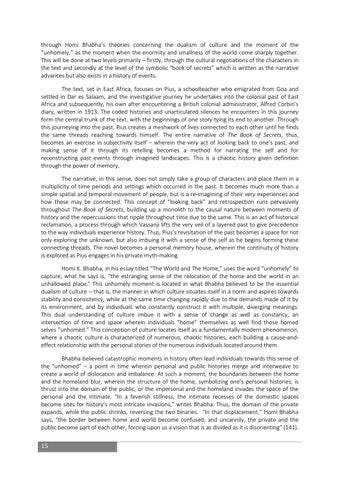through Homi Bhabha’s theories concerning the dualism of culture and the moment of the “unhomely,” as the moment when the enormity and smallness of the world come sharply together. This will be done at two levels primarily – firstly, through the cultural negotiations of the characters in the text and secondly at the level of the symbolic “book of secrets” which is written as the narrative advances but also exists in a history of events. The text, set in East Africa, focuses on Pius, a schoolteacher who emigrated from Goa and settled in Dar es Salaam, and the investigative journey he undertakes into the colonial past of East Africa and subsequently, his own after encountering a British colonial administrator, Alfred Corbin’s diary, written in 1913. The coded histories and unarticulated silences he encounters in this journey form the central trunk of the text, with the beginnings of one story tying its end to another. Through this journeying into the past, Pius creates a meshwork of lives connected to each other until he finds the same threads reaching towards himself. The entire narrative of The Book of Secrets, thus, becomes an exercise in subjectivity itself – wherein the very act of looking back to one’s past, and making sense of it through its retelling becomes a method for narrating the self and for reconstructing past events through imagined landscapes. This is a chaotic history given definition through the power of memory. The narrative, in this sense, does not simply take a group of characters and place them in a multiplicity of time periods and settings which occurred in the past. It becomes much more than a simple spatial and temporal movement of people, but is a re-imagining of their very experiences and how these may be connected. This concept of “looking back” and retrospection runs pervasively throughout The Book of Secrets, building up a monolith to the causal nature between moments of history and the repercussions that ripple throughout time due to the same. This is an act of historical reclamation, a process through which Vassanji lifts the very veil of a layered past to give precedence to the way individuals experience history. Thus, Pius’s revisitation of the past becomes a space for not only exploring the unknown, but also imbuing it with a sense of the self as he begins forming these connecting threads. The novel becomes a personal memory house, wherein the continuity of history is explored as Pius engages in his private myth-making. Homi K. Bhabha, in his essay titled “The World and The Home,” uses the word “unhomely” to capture, what he says is, “the estranging sense of the relocation of the home and the world in an unhallowed place.” This unhomely moment is located in what Bhabha believed to be the essential dualism of culture – that is, the manner in which culture situates itself in a norm and aspires towards stability and consistency, while at the same time changing rapidly due to the demands made of it by its environment, and by individuals who constantly construct it with multiple, diverging meanings. This dual understanding of culture imbue it with a sense of change as well as constancy, an intersection of time and space wherein individuals “home” themselves as well find those homed selves “unhomed.” This conception of culture locates itself as a fundamentally modern phenomenon, where a chaotic culture is characterized of numerous, chaotic histories, each building a cause-andeffect relationship with the personal stories of the numerous individuals located around them. Bhabha believed catastrophic moments in history often lead individuals towards this sense of the “unhomed” – a point in time wherein personal and public histories merge and interweave to create a world of dislocation and imbalance. At such a moment, the boundaries between the home and the homeland blur, wherein the structure of the home, symbolizing one’s personal histories, is thrust into the domain of the public, or the impersonal and the homeland invades the space of the personal and the intimate. “In a feverish stillness, the intimate recesses of the domestic spaces become sites for history’s most intricate invasions,” writes Bhabha. Thus, the domain of the private expands, while the public shrinks, reversing the two binaries. “In that displacement,” Homi Bhabha says, “the border between home and world become confused; and uncannily, the private and the public become part of each other, forcing upon us a vision that is as divided as it is disorienting” (141). 15
Issuu converts static files into: digital portfolios, online yearbooks, online catalogs, digital photo albums and more. Sign up and create your flipbook.

